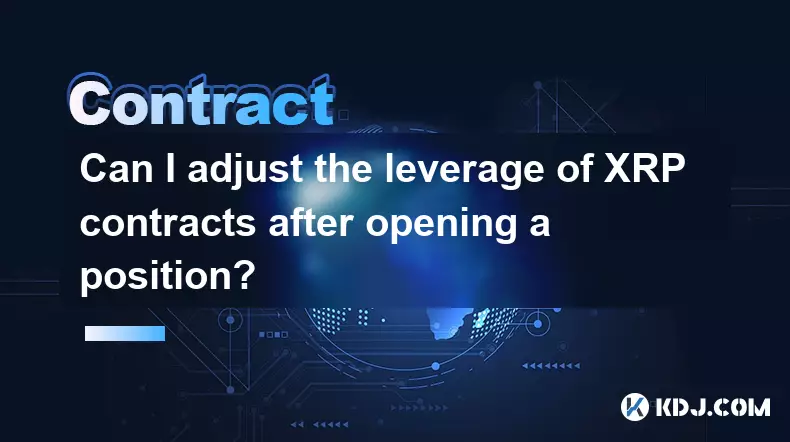-
 bitcoin
bitcoin $124586.364639 USD
0.62% -
 ethereum
ethereum $4670.671710 USD
3.33% -
 xrp
xrp $2.983701 USD
0.18% -
 tether
tether $1.000175 USD
-0.03% -
 bnb
bnb $1209.430642 USD
2.76% -
 solana
solana $231.365861 USD
0.51% -
 usd-coin
usd-coin $0.999665 USD
-0.02% -
 dogecoin
dogecoin $0.264657 USD
4.46% -
 tron
tron $0.346415 USD
1.60% -
 cardano
cardano $0.871586 USD
3.70% -
 chainlink
chainlink $23.451270 USD
7.56% -
 hyperliquid
hyperliquid $46.860071 USD
-2.96% -
 ethena-usde
ethena-usde $1.000120 USD
0.04% -
 sui
sui $3.611279 USD
1.08% -
 stellar
stellar $0.407149 USD
0.96%
Can I adjust the leverage of XRP contracts after opening a position?
Adjusting leverage in XRP futures changes your margin and liquidation price, amplifying both risk and reward—use it wisely to manage exposure.
Sep 24, 2025 at 11:36 am

Understanding Leverage in XRP Futures Trading
1. Leverage allows traders to control a larger position using a relatively small amount of capital. In the context of XRP futures, this means that even minor price fluctuations can lead to significant gains or losses. Traders often open positions with a predetermined leverage level based on their risk tolerance and market outlook.
2. Most major cryptocurrency exchanges that support XRP perpetual or futures contracts provide the option to adjust leverage after a position has been opened. This functionality is essential for managing risk dynamically as market conditions change. Platforms like Binance, Bybit, and OKX include user interfaces where leverage can be modified directly from the active position panel.
3. Adjusting leverage does not alter the entry price or the total quantity of the position. Instead, it recalculates the margin allocated to that trade, which impacts liquidation price and potential exposure. Increasing leverage reduces the buffer against adverse price movements, while decreasing leverage can protect the position from sudden volatility.
4. It's important to note that leverage adjustments are subject to exchange-specific rules. Some platforms restrict changes if the position is close to liquidation or if maintenance margin thresholds are being tested. Traders must ensure sufficient available balance in their wallet to support any leverage increase, as higher leverage demands more margin.
5. The ability to modify leverage offers strategic flexibility. For example, a trader might reduce leverage after a favorable price move to lock in profits and lower risk, or increase it during a strong trend confirmation—though the latter increases vulnerability to reversals.
Impact of Leverage Changes on Liquidation Price
1. The liquidation price is directly influenced by the leverage applied to a position. When leverage is increased, the liquidation price moves closer to the current market price because less price movement is required to deplete the margin. This makes the position more susceptible to being closed out automatically.
2. Conversely, reducing leverage pushes the liquidation price further away from the current mark, providing a larger safety zone. This is particularly useful during periods of high volatility or when a trader plans to hold a position over an extended period without constant monitoring.
Traders should monitor their liquidation price closely after adjusting leverage to avoid unexpected closures, especially in fast-moving markets.3. Exchanges typically display real-time updates to the liquidation price as leverage is modified. This allows users to experiment with different levels in a preview mode before confirming the change, minimizing the risk of accidental exposure.
4. Some trading interfaces allow setting stop-loss or take-profit orders alongside leverage adjustments, creating a layered risk management strategy. However, these tools do not prevent liquidation if the price hits the threshold before the order is executed.
Risks and Best Practices in Dynamic Leverage Management
1. Frequent changes to leverage can reflect emotional decision-making, especially during sharp price swings. Traders may be tempted to increase leverage after seeing unrealized gains, which amplifies risk at potentially vulnerable moments.
2. A disciplined approach involves setting predefined rules for when to adjust leverage, such as after a certain percentage move in the asset price or upon reaching specific technical levels. This removes impulsive actions from the trading process.
3. It is critical to understand that increasing leverage does not improve the probability of success—it only magnifies outcomes, both positive and negative. A well-structured trading plan should account for worst-case scenarios even after leverage modifications.
4. Always verify the margin balance before making adjustments. Insufficient funds can prevent a leverage decrease if additional margin is required due to recent price action, leaving the position exposed.
5. Different exchanges implement leverage mechanics differently. Some apply cross-margin settings by default, where the entire account balance acts as collateral, while isolated margin confines risk to a specified amount. Knowing which model applies is essential when modifying leverage.
Frequently Asked Questions
Can I change leverage on a leveraged XRP position during high market volatility?Yes, most platforms allow leverage adjustments during volatile conditions, but execution speed may vary. Some exchanges temporarily restrict changes if system load is high or if the position is near liquidation.
Does changing leverage affect my open fees or funding payments?No, funding rates and transaction fees are calculated based on position size and holding duration, not leverage level. Adjusting leverage does not trigger new fees.
What happens if I try to increase leverage but don’t have enough margin?The system will reject the request. You must either deposit additional funds, reduce the position size, or wait for unrealized profits to accumulate before proceeding.
Is it possible to set automatic leverage adjustment rules?Currently, no major exchange supports automated leverage scaling. All changes must be initiated manually through the trading interface or API with explicit user authorization.
Disclaimer:info@kdj.com
The information provided is not trading advice. kdj.com does not assume any responsibility for any investments made based on the information provided in this article. Cryptocurrencies are highly volatile and it is highly recommended that you invest with caution after thorough research!
If you believe that the content used on this website infringes your copyright, please contact us immediately (info@kdj.com) and we will delete it promptly.
- BlockDAG, DOGE, HYPE Sponsorship: Crypto Trends Shaping 2025
- 2025-10-01 00:25:13
- Deutsche Börse and Circle: A StableCoin Adoption Powerhouse in Europe
- 2025-10-01 00:25:13
- BlockDAG's Presale Buzz: Is It the Crypto to Watch in October 2025?
- 2025-10-01 00:30:13
- Bitcoin, Crypto, and IQ: When Genius Meets Digital Gold?
- 2025-10-01 00:30:13
- Stablecoins, American Innovation, and Wallet Tokens: The Next Frontier
- 2025-10-01 00:35:12
- NBU, Coins, and Crypto in Ukraine: A New Yorker's Take
- 2025-10-01 00:45:14
Related knowledge

What is the difference between futures and perpetual contracts for Bitcoin?
Oct 02,2025 at 11:54pm
Understanding Bitcoin Futures Contracts1. Bitcoin futures are derivative instruments that allow traders to speculate on the future price of Bitcoin at...

What is the best time to trade PEPE contracts?
Oct 03,2025 at 11:54am
Understanding PEPE Contract Volatility1. PEPE contracts exhibit extreme price fluctuations due to their meme-based nature and low market cap. Trading ...

What are the common mistakes to avoid with Bitcoincoin contracts?
Oct 03,2025 at 08:54am
Emerging Trends in the Cryptocurrency Market1. Decentralized finance (DeFi) platforms continue to expand their influence across the blockchain ecosyst...

What is the maintenance margin for Bitcoin contracts?
Oct 02,2025 at 01:36am
Decentralized Exchanges Gain Momentum in 20241. Decentralized exchanges (DEXs) have seen a significant rise in trading volume, surpassing centralized ...

How to use technical analysis for trading XRP contracts?
Oct 03,2025 at 01:18pm
Understanding Price Patterns in XRP Futures1. Identifying chart patterns such as triangles, head and shoulders, and double tops or bottoms can provide...

What does "longing" PEPE contracts mean?
Oct 03,2025 at 11:54pm
Understanding Decentralized Exchanges in the Crypto Ecosystem1. Decentralized exchanges (DEXs) operate without a central authority, allowing users to ...

What is the difference between futures and perpetual contracts for Bitcoin?
Oct 02,2025 at 11:54pm
Understanding Bitcoin Futures Contracts1. Bitcoin futures are derivative instruments that allow traders to speculate on the future price of Bitcoin at...

What is the best time to trade PEPE contracts?
Oct 03,2025 at 11:54am
Understanding PEPE Contract Volatility1. PEPE contracts exhibit extreme price fluctuations due to their meme-based nature and low market cap. Trading ...

What are the common mistakes to avoid with Bitcoincoin contracts?
Oct 03,2025 at 08:54am
Emerging Trends in the Cryptocurrency Market1. Decentralized finance (DeFi) platforms continue to expand their influence across the blockchain ecosyst...

What is the maintenance margin for Bitcoin contracts?
Oct 02,2025 at 01:36am
Decentralized Exchanges Gain Momentum in 20241. Decentralized exchanges (DEXs) have seen a significant rise in trading volume, surpassing centralized ...

How to use technical analysis for trading XRP contracts?
Oct 03,2025 at 01:18pm
Understanding Price Patterns in XRP Futures1. Identifying chart patterns such as triangles, head and shoulders, and double tops or bottoms can provide...

What does "longing" PEPE contracts mean?
Oct 03,2025 at 11:54pm
Understanding Decentralized Exchanges in the Crypto Ecosystem1. Decentralized exchanges (DEXs) operate without a central authority, allowing users to ...
See all articles










































































